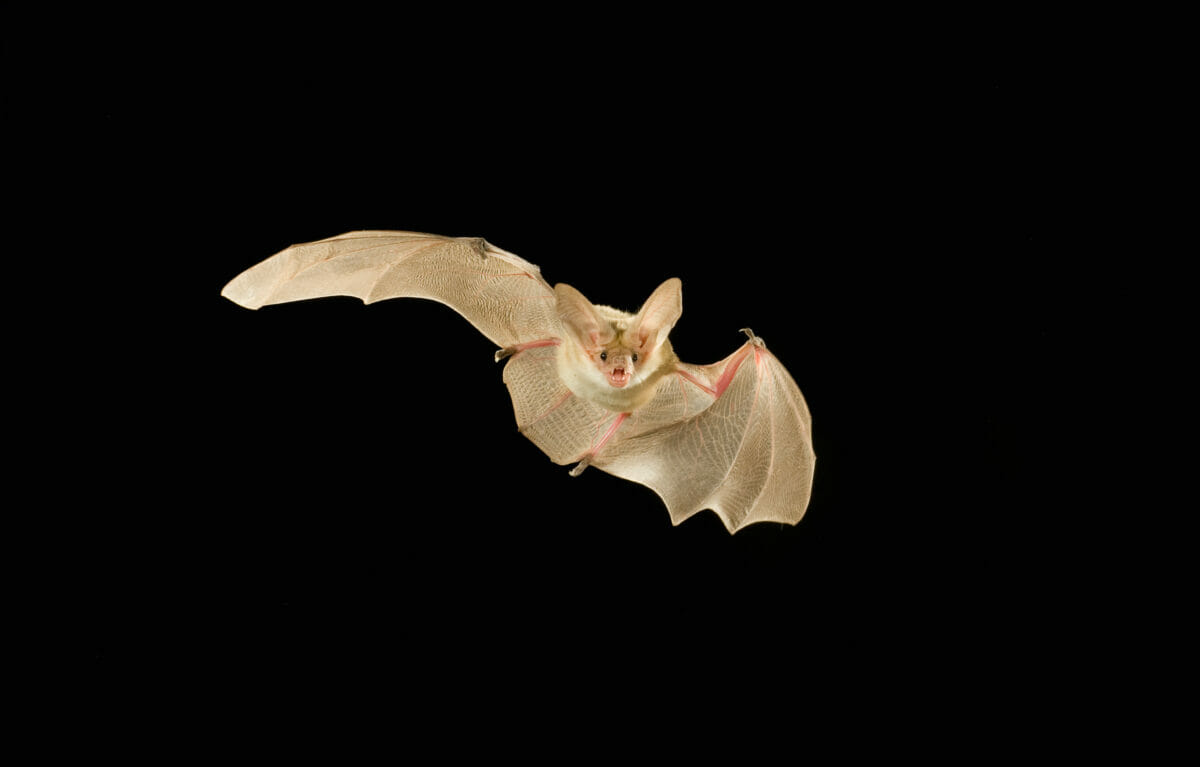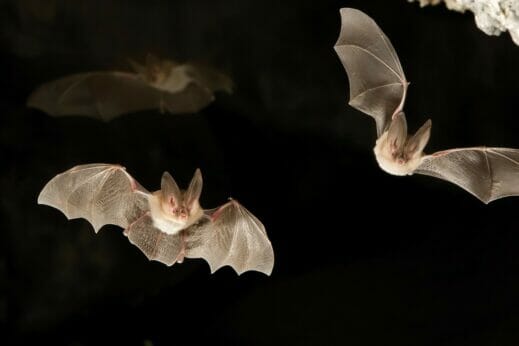Over Half of Bat Species Are At Severe Risk
A new report from the North American Bat Conservation Alliance shows that half of all bats are at risk of dying out in the next 15 years, mainly due to climate change.
Over Half of Bat Species Are At Severe Risk
A new report from the North American Bat Conservation Alliance shows that half of all bats are at risk of dying out in the next 15 years, mainly due to climate change.

A California leaf-nosed bat flies at night, Copper Mountains, Cabeza Prieta National Wildlife Refuge, Arizona.Michael Durham/Minden Pictures, Bat Conservation International
When the North American Bat Conservation Alliance (NABCA) released its first ever State of Bats report this spring, it was intended as a baseline record of how bat species in North America were faring. NABCA is a trilateral network, with biologists and resource managers across Canada, the US and Mexico. With hundreds of bat species traveling throughout the continent, scientists wanted to assess how things were going.
The results were stark.
The data show that 52 percent of all bat species are at severe risk of population decline in just 15 years and more than 82 percent of all species will be impacted by climate change. The researchers assessed the population status of roughly 200 bat species across North America, looked at trends and predicted what might happen over the next decade and a half. Then, they ranked the bats in terms of which species are most at risk.
“It is alarming,” says Dr. Winifred Frick, the chief scientist with Bat Conservation International. “One of the things that is sort of shocking from the report and that we need to be paying close attention to is just how the cumulative, chronic stressors of habitat loss and climate change add up to this overall grim picture.”

Warming climates have reduced bat species across North America. Extreme temperatures, such as heatwaves and winter storms, continue to threaten bats, while drought is a huge concern. Without access to enough water, bats will fail to reproduce and could die themselves, putting multiple generations at risk.
There’s also expansion and development, which encroach on bat areas. But major expansion of logging in Canada, fire in the United States and livestock ranching in Mexico have drastically reduced safe areas for bats. As a result, 98 percent of bat species are losing habitat.
There are also biological and viral factors, such as white nose syndrome, which has caused a more than 90 percent decline in three different species of bat in just the last decade. And there are environmental factors, such as wind turbines and wind energy facilities, that kill a significant number of bats each year.
“We’re estimating that over half a million bats in the US alone are killed by wind turbines [each year],” says Frick. While Frick and NABCA want to see that number reduced, they also support greener energy alternatives. But Frick says the choice doesn’t have to be either/or. Engineers can change the wind speeds at which the turbine blades spin because “we know most of the bat fatalities happen on low wind speed nights,” she says. There is also research going into where to put wind turbines for lower ecological disruption and ways to reduce bat attraction to the turbines, perhaps through sound wave disruption. While that research is still new, Frick says it’s important to support renewable energy infrastructures without risking species biodiversity.
As Frick notes, bats are incredibly important contributors to ecological stability. They make up 20 percent of all mammalian biodiversity on the planet and work as pollinators and seed dispersers, especially through tropical rainforests. “Bats are voracious predators, and it’s been estimated that they save the agricultural industry in the United States alone billions of dollars annually by eating crop pests,” says Frick. Plus, she says, bats are just cool. They bring in tourism dollars in parts of Mexico and US, such as the Congress Avenue Bridge, in Austin TX. They’ve been a source of media fascination for decades. “I always like to point out that we wouldn’t have Batman as a superhero without bats,” she says. “They make our art and our literature and our technology richer and more interesting. There’s some incredible adaptations with sonar and echo-location because of bats.”

While the report shows some scary numbers, Frick says the good news is that it represents a starting place for researchers. Much of this information didn’t exist before, so having a sense of where bat species are is the first step. From here, researchers are looking to check in and survey the species in intervals of five years. Some of the information may end up being updated yearly, through initiatives such as the North American Bat Monitoring Program. But the most in-depth research takes time.
In the meantime, although it may feel like an overwhelming problem at times, there are actions that individuals can take. Frick says that letting old trees stand on your property can help provide homes for bats. Planting native plants and reducing pesticide use helps provide food for bats in the form of moths and beetles. And if you’re in an arid area, providing water sources for bats can be a big help.
There is one main positive takeaway from the State of Bats report: the trilateral co-operation and work between scientists in three different countries. As Frick says, we need to think about conservation not just at an individual or community level, and “not just within our geopolitical boundaries, but also with our neighbors and at continental scales.”
Follow us
This work is licensed under a Creative Commons Attribution-NoDerivatives 4.0 International License.
Want to republish a Modern Farmer story?
We are happy for Modern Farmer stories to be shared, and encourage you to republish our articles for your audience. When doing so, we ask that you follow these guidelines:
Please credit us and our writers
For the author byline, please use “Author Name, Modern Farmer.” At the top of our stories, if on the web, please include this text and link: “This story was originally published by Modern Farmer.”
Please make sure to include a link back to either our home page or the article URL.
At the bottom of the story, please include the following text:
“Modern Farmer is a nonprofit initiative dedicated to raising awareness and catalyzing action at the intersection of food, agriculture, and society. Read more at <link>Modern Farmer</link>.”
Use our widget
We’d like to be able to track our stories, so we ask that if you republish our content, you do so using our widget (located on the left hand side of the article). The HTML code has a built-in tracker that tells us the data and domain where the story was published, as well as view counts.
Check the image requirements
It’s your responsibility to confirm you're licensed to republish images in our articles. Some images, such as those from commercial providers, don't allow their images to be republished without permission or payment. Copyright terms are generally listed in the image caption and attribution. You are welcome to omit our images or substitute with your own. Charts and interactive graphics follow the same rules.
Don’t change too much. Or, ask us first.
Articles must be republished in their entirety. It’s okay to change references to time (“today” to “yesterday”) or location (“Iowa City, IA” to “here”). But please keep everything else the same.
If you feel strongly that a more material edit needs to be made, get in touch with us at [email protected]. We’re happy to discuss it with the original author, but we must have prior approval for changes before publication.
Special cases
Extracts. You may run the first few lines or paragraphs of the article and then say: “Read the full article at Modern Farmer” with a link back to the original article.
Quotes. You may quote authors provided you include a link back to the article URL.
Translations. These require writer approval. To inquire about translation of a Modern Farmer article, contact us at [email protected]
Signed consent / copyright release forms. These are not required, provided you are following these guidelines.
Print. Articles can be republished in print under these same rules, with the exception that you do not need to include the links.
Tag us
When sharing the story on social media, please tag us using the following: - Twitter (@ModFarm) - Facebook (@ModernFarmerMedia) - Instagram (@modfarm)
Use our content respectfully
Modern Farmer is a nonprofit and as such we share our content for free and in good faith in order to reach new audiences. Respectfully,
No selling ads against our stories. It’s okay to put our stories on pages with ads.
Don’t republish our material wholesale, or automatically; you need to select stories to be republished individually.
You have no rights to sell, license, syndicate, or otherwise represent yourself as the authorized owner of our material to any third parties. This means that you cannot actively publish or submit our work for syndication to third party platforms or apps like Apple News or Google News. We understand that publishers cannot fully control when certain third parties automatically summarize or crawl content from publishers’ own sites.
Keep in touch
We want to hear from you if you love Modern Farmer content, have a collaboration idea, or anything else to share. As a nonprofit outlet, we work in service of our community and are always open to comments, feedback, and ideas. Contact us at [email protected].by Emily Baron Cadloff, Modern Farmer
July 5, 2023
Modern Farmer Weekly
Solutions Hub
Innovations, ideas and inspiration. Actionable solutions for a resilient food system.
ExploreExplore other topics
Share With Us
We want to hear from Modern Farmer readers who have thoughtful commentary, actionable solutions, or helpful ideas to share.
SubmitNecessary cookies are absolutely essential for the website to function properly. This category only includes cookies that ensures basic functionalities and security features of the website. These cookies do not store any personal information.
Any cookies that may not be particularly necessary for the website to function and are used specifically to collect user personal data via analytics, ads, other embedded contents are termed as non-necessary cookies.
”The UN was told in 2007 that chemtrails trap warmth and create global warming – helping to convince the nutters that climate change is real.”
I raise tilapia on my farm and have plenty of brown bats! Many of the bats at my former location have migrated and followed me to my new location. Mosquitoes provide chitin for my tilapia and abundant feed for the bats! I clap and whistle and they swoop down close then jet away! Made a Bat House last year out of rotting pallet wood. Every animal plays a role. This is Life